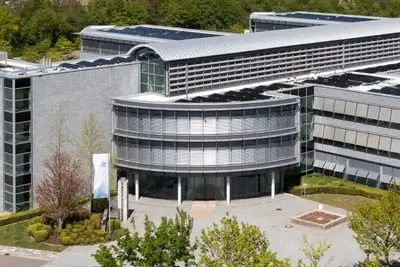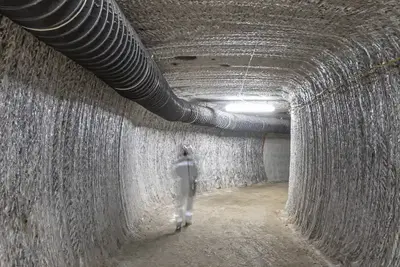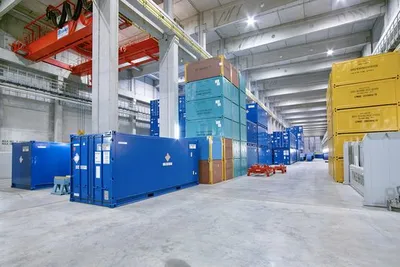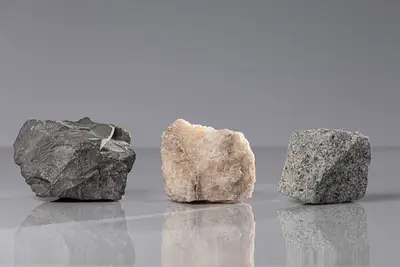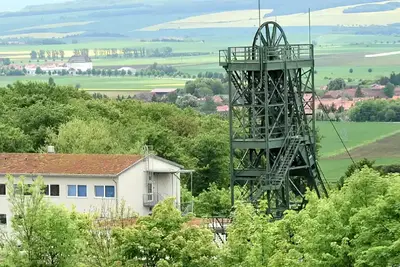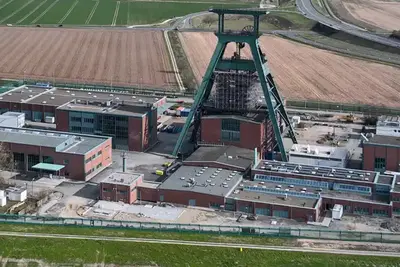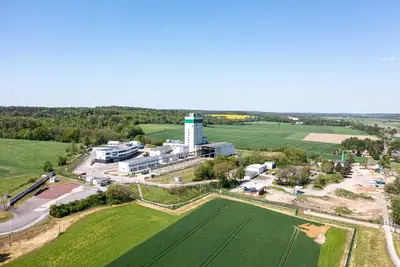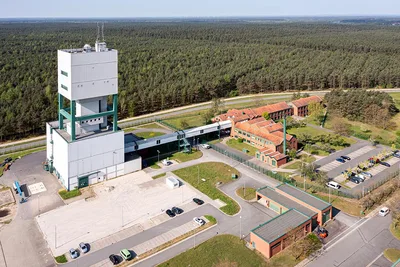Announcement - Asse II mine
21 July 2017: Information event on Asse inflow waters
On 18 July 2017, the Bundesgesellschaft für Endlagerung mbH (BGE) as operator of the Asse II shaft mine and Asse GmbH as managing company in Sehnde gave information about plans for the discharge of radiologically harmless inflow waters into the Bergmannssegen-Hugo mine. The BGE and Asse GmbH accepted an invitation from the local council in Sehnde and the Specialist Committee for Urban Development and the Environment. Many interested citizens came to the public event to obtain information about the planned project. Those present expressed their concerns and fears about the planning and used the opportunity for questions and discussion. The principle questions and answers are presented here, so as to offer the same level of information to all interested parties. If you have any further questions, please contact info-asse(at)bge.de. In addition, we invite all interested citizens to compile their own personal impression of the Asse II shaft mine and the challenges associated with it. Visit us at the Asse Info Centre or register for an underground tour. Further information can be found here.
Questions and answers are categorised as follows:
- Inflow waters and disposal options
- Bergmannssegen-Hugo mine recycling option
- Inflow waters measurement values
- Inflow waters transportation
- Further questions
Inflow waters and disposal options
How is solution management looking generally in the Asse II shaft mine? Currently, around 12.5 cubic metres of groundwater (inflow waters) saturated with rock salt are captured every day in the Asse II shaft mine. Over 90 per cent (around 11.5 cubic metres per day) is captured at the main collecting point at the 658 metre level. The solution captured there is radiologically harmless as it has had no contact with the radioactive waste. This is proven by measurements at every emission point from the mine. Release is effected according to Article 29 of the Radiation Protection Ordinance. All inflow waters captured beneath the 658 metre level remain in the mine and are used predominantly for concrete manufacturing. A small part of it (on average around 20 litres per day) has contact with the radioactive waste and is therefore contaminated. This solution also remains in the mine and is not delivered to the surface. Further information on solution management can be found in the brochure “Asse II mine. Status of works for retrieval” How are the inflow solutions currently disposed of? The inflow solutions, which are collected in the main collecting point at the 658 metre level, are currently subjected to further industrial processing. Until the end of 2016, discharge took place into the Mariaglück mine near Höfer in the Celle district. Which options for the disposal of inflow waters are being pursued? The primary recipient of the inflow solution is currently an industrial company that uses the rock salt solution as a base material for further production processes. Due to technical, weathering-related and other scenarios, further discharge may under certain conditions not be possible in future, either temporarily or permanently. In the sense of the precautionary principle under Atomic Law, the BGE as responsible operator must create possible alternatives. Besides the discharge of the solution into a mine, the delivery of the solution into the Elbe or discharge into the North Sea is also to be tested. Regarding delivery into the Elbe, an application has already been made to the responsible licencing authorities. It cannot currently be predicted whether and to what extent these back-up options will be used in future. In any case, only radiologically harmless solutions that have been approved under Article 29 of the Radiation Protection Ordinance are discharged. top
Bergmannssegen-Hugo mine recycling option
To what extent should inflow waters from Asse be discharged into the Bergmannssegen-Hugo mine? Currently around 11.5 cubic metres of inflow waters per day are captured at the main collecting point at the 658 metre level. This corresponds to an annual volume of around 4,200 cubic metres. As this recycling of salt solutions to flood the Bergmannssegen-Hugo mine is a back-up option, it can be expected that the actual occurrence will be significantly lower. When is the soonest that solutions from Asse could be brought to Sehnde? Because of the licencing procedure still to be undergone and the establishment of the necessary technical facilities, discharge could begin at the earliest in early 2018. However, as this is simply a back-up option, it cannot currently be foreseen whether or when solutions from Asse will be delivered into the Bergmannssegen-Hugo mine. For what duration might water from Asse be brought to Sehnde? Currently (as of April 2017), there are around 7.6 million cubic metres of cavity available in the Bergmannssegen-Hugo mine. The maximum daily flood volume is technically limited to around 12,000 cubic metres. K+S aims to advance the flooding rapidly and promptly bring it to an end. The precise end of the flooding depends on the quantities of media introduced. These consist predominantly of saline solutions the arise during potash production. Is there a risk in future that contaminated solutions will also be delivered to Sehnde? The atomic and radiation protection regulations prohibit discharge of contaminated solutions from the Asse II shaft mine. Discharge of contaminated solutions will not occur at any time. Is the Bergmannssegen-Hugo mine a former potash mine? Can the sodium chloride solution lead to dissolving processes? The flooding of the mine is generally arranged in such a way that even non-mineralised process water can be used without damaging the stability of the mine structure. The fact is that if all of the currently deliverable non-contaminated solutions from the Asse II shaft mine are delivered to the mine, the solutions from Asse would add up to around 0.3 per cent of the annually delivered solution. As this recycling in the Bergmannssegen-Hugo mine is a back-up option, it can be presumed that the actual delivery of inflow solutions will be significantly lower. top
Inflow waters measurement values
How are the contents of the solutions measured and how frequently are measurements carried out? Before the inflow waters are discharged, these are tested for radioactive materials. Reference nuclides are tritium and caesium-137. Measurement takes place as part of an approval procedure according to Article 29 of the Radiation Protection Ordinance. The water be discharged only when this approval procedure demonstrates that it is radiologically harmless. The measurements are currently carried out by VKTA Rossendorf. In addition, samples of all component parts are investigated every three months. Analysis of trace elements will display the tiniest changes in the composition of the solution. Which materials are present in the solution? The inflow waters to be discharged are a saturated rock salt solution. This is radiologically harmless, and this is confirmed by regular measurements. The measurements are carried out before each and every discharge of solution from the mine. The radionuclide tritium is the only significant factor in the discharge of inflow waters. This radioactive gas escapes from the storage chambers and is found in the mine air in the Asse II shaft mine. It can accumulate in watery solutions and thus also in the inflow waters to be discharged, which are captured in the main collecting point at the 658 metre level. The measurements show that the tritium concentration is far below the limit value set by the Drinking Water Ordinance. The Drinking Water Ordinance sets a limit value of 100 becquerels per litre (1 becquerel = 1 unit of nuclear decay per second). The inflow waters to be discharged show a tritium concentration of 2 to 5 becquerels per litre. Caesium-137 has not been seen. The measurement values from the first six months of 2017 can be found here. Earlier measurement values can be found on the archive site of the Federal Office for Radiation Protection. Who guarantees the independence of the measurements? The measurements are carried out by recognised institutions. So as to strengthen the trust of citizens, BGE and Asse-GmbH have proposed that for example the local political decision-makers can name a measuring institution to carry out checking measurements. This will be funded by the BGE. top
Inflow waters transportation
How will delivery of inflow waters take place? Delivery will take place by HGV. If all inflow waters currently to be discharged from the Asse II shaft mine are brought to the Bergmannssegen-Hugo mine, this would mean that on average around 6 HGVs per day would deliver the solution on two to three days every six weeks. As this disposal in the Bergmannssegen-Hugo mine is a back-up option, it can be expected that the actual occurrence will be significantly lower. If possible, road transport will be planned in such a way that disruption to residents, for example from noise, will be minimised. If inflow waters really are harmless, why are they transported in a closed system? The capture basin at the 658 metre level and the collecting basins at the 490 metre level are covered so as to keep the tritium concentration as low as possible. This is in compliance with instructions set out in Atomic Law and the Radiation Protection Ordinance (minimisation requirement under Article 6 of the Radiation Protection Ordinance). Tritium escapes from the storage chamber and is found in the mine air in the Asse II shaft mine. It can accumulate in watery solutions and thus also in the inflow waters to be discharged. Covering the collecting basins minimises the accumulation of tritium in the discharged solutions. If the inflow waters are transported above ground, this is done in closed and sealed HGVs so as to prevent any influence to the inflow waters from outside. This provides complete verification that the solutions to be discharged are radiologically harmless. What happens if the HGVs carrying the solution have an accident? Are these specially labelled? A case like this has not occurred in recent years but it cannot be ruled out in the future. From a radiological point of view, there is absolutely no danger to the population or the environment because of the proven harmlessness. An accident would be handled appropriately like any other traffic accident by the relevant emergency services/fire brigade (e.g. solution would be collected and pumped away). Special protection measures, such as those used for accidents involving hazardous materials (heating oil, petrol and diesel, chemicals), are not required. As the inflow waters to be discharged are not a hazardous material, special labelling is not required. top
Further questions
Who are the stakeholders involved in the procedure? The discharge of radiologically harmless saline solutions from the Asse II shaft mine must be licenced in a licencing procedure under mining law by the relevant state authority for mining, energy and geology (LBEG). The specialist oversight body is the Lower Saxony Ministry for the Environment, Energy and Climate Protection. The licencing application (for the recycling of inflow solutions for flooding the mine) must be made to the LBEG by K+S as operator of the Bergmannssegen-Hugo mine. This body checks the application for the presence of all documentation. Does Asse-GmbH pay for the disposal of inflow waters from the Asse II shaft mine? The parties to the remuneration agreement have agreed a policy of non-disclosure about the agreement. Costs for the building measures that form part of the planned discharge of inflow waters from Asse onto the K+S site are paid by Asse-GmbH. top

